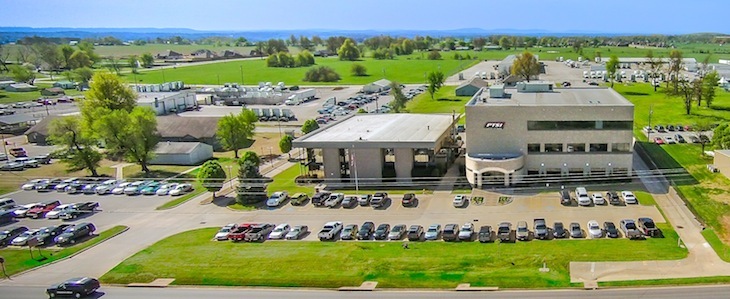P.A.M. adds freight during GM strike; retains drivers, office staff
by October 28, 2019 2:10 pm 868 views

P.A.M. Transportation headquarters in Tontitown, Ark.
While the General Motors strike has ended, Tontitown-based carrier P.A.M. Transportation Services Inc. looks to continue to haul the new freight it started to handle to make up for the freight that had stopped during the strike.
In recent FreightWaves’ podcasts, P.A.M. executives spoke about how the company developed new freight opportunities with customers and didn’t lay off any driver or office employee as a result of the strike.
David Ables, vice president of operations for P.A.M., said the company runs 400 trucks in the General Motors market. As the carrier’s largest customer, the automotive company accounts for less than 20% of the carrier’s business, P.A.M. President Daniel Cushman said. When Cushman started at P.A.M. about 10 years ago, General Motors accounted for 63% of the carrier’s business. Ables spoke in a recent What the Truck podcast, and Cushman spoke in a recent Fuller Speed Ahead podcast.
Members of United Automobile Workers were on strike for 40 days. It affected about 48,000 workers and was projected to cost General Motors nearly $2 billion. Ables said the day after the strike started, the carrier’s service team, pricing team and interns from the Sam M. Walton College of Business at the University of Arkansas were seeking new opportunities. The carrier worked with 15 customers to find enough freight for the 400 truck drivers that had been dedicated to haul General Motors freight. The new freight accounted for $2.2 million in new business that the carrier didn’t have before the strike, Ables said. He hopes the carrier will be able to continue to hauling the freight after the strike.
In June, P.A.M. established a new facility in Fort Wayne, Ind., that was dedicated to General Motors freight. Drivers who operated from there were those who would come home nightly, Ables said, adding that the carrier didn’t lay off any of these drivers and covered the drivers’ pay “out of our own pocket.”
He explained the drivers of the General Motors freight were able to remain on a similar driving schedule. They started to handle the freight that previously other drivers who had hauled freight along similar corridors would have. Meanwhile, the other drivers started to handle the new freight that the carrier found.
“We couldn’t just sit back and be a victim,” Ables said. “We have to think outside the box.” Ables said Cushman pushed him to find a solution. He worked with brokers to help find freight for drivers. Also, the UA intern had attended a recent seminar, and an executive of Bentonville-based retailer Walmart asked about how the strike was impacting the carrier. Afterward, Walmart put 100 of the trucks affected by the strike to work, Ables said.
The strike came after the carrier had experienced records in 13 out of 14 months in a row, he said. The carrier has about 2,000 trucks, and about 1.6% of the freight it hauls is a result of a brokerage transaction.
“We’ve been somewhat protected from that spot market, but it’s definitely taken its toll on multiple carriers,” Ables said. Dry-van spot rates fell 14% in September, from the same month in 2018, according to DAT Solutions.
“At the end of the day we want to take care of our drivers,” Ables said. “Our drivers take care of us.”
Cushman referred to the strike as a “gut punch” and explained how over the past 10 years the carrier has changed its freight mix. The automotive industry accounts for 50% of the carrier’s business. Also, 50% of the carrier’s business can be attributed to freight it hauls across the border. When the strike started, he asked if any drivers would like to take off time, but they didn’t. Since the start of the strike, the carrier has increased its fleet by 10 drivers, he said.
Cushman also discussed concerns related to younger generations not buying as many vehicles and the impact of autonomous vehicles. He noted that car manufacturers are making fewer vehicles, but it’s still making 16.5 million vehicles. And, the carrier isn’t hauling all of the freight for the carmakers.
P.A.M. grew 20% in 2018, and Cushman said he expects the company will continue to grow but not at that rate for 2019.
In the third quarter, earnings fell 50.5% to $4.58 million, or 79 cents per share, from $9.25 million, or $1.52 per share, in the same period in 2018. Through three quarters, net income has risen 20.2% to $21.54 million, or $3.65 per share, from $17.92 million, or $2.89 per share, in the same period in 2018. Revenue fell 8.1% to $128.99 million in the third quarter, from $140.33 million in the same period in 2018. Through three quarters, revenue has decreased by 1.1% to $390.68 million, from $395.09 million in the same period in 2018.
Shares of P.A.M. (NASDAQ: PTSI) were trading Monday (Oct. 28) at $57.40, down 50 cents or 0.86%. In the past 52 weeks, the stock has traded between $71.56 and $34.31.
